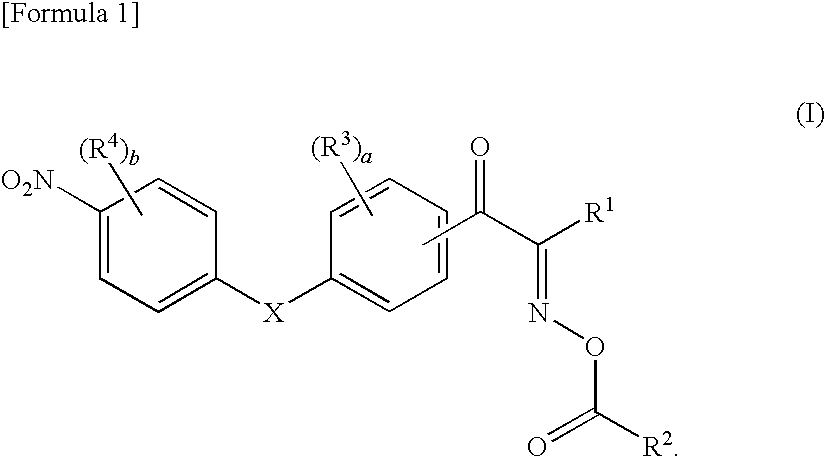Oxime ester compound and photopolymerization initiator containing the same
a technology of oxime ester and initiator, which is applied in the direction of photosensitive materials, instruments, photomechanical apparatuses, etc., can solve the problems of insufficient sensitivity of known o-acyl oxime compounds, and achieve the effect of efficient absorption and high sensitivity
- Summary
- Abstract
- Description
- Claims
- Application Information
AI Technical Summary
Benefits of technology
Problems solved by technology
Method used
Image
Examples
example 1
Preparation of Compound No. 1
Step 1—Preparation of Sulfide Compound
[0065]In a nitrogen atmosphere, 31.6 g (200 mmol) of p-chloronitrobenzene, 24.2 g (220 mmol) of thiophenol, and 139 g of dimethylacetamide were put in a reactor, and 25.0 g (300 mmol) of sodium hydroxide was added thereto, followed by stirring at 50° C. for 1 hour. After cooling to room temperature, the reaction mixture was subjected to oil-water separation using ethyl acetate / water. The solvent was removed by evaporation to give 46.2 g (99%) of yellow crystals (HPLC purity: 99%).
Step 2—Preparation of Acylated Compound
[0066]In a nitrogen atmosphere 64.0 g (480 mmol) of aluminum chloride and 186 g of dichloroethane were put in a reactor. To the reactor were slowly added dropwise 27.8 g (180 mmol) of phenylacetyl chloride, 34.7 g (150 mmol) of the sulfide compound obtained in step 1 above, and 186 g of dichloroethane in the order described under cooling with ice, followed by stirring at 5° C. for 30 minutes. The reacti...
example 1b
Preparation of Compound No. 15
Step 1—Preparation of Acylated Compound
[0077]In a nitrogen atmosphere 3.52 g (26.4 mmol) of aluminum chloride and 16 g of dichloroethane were put in a reactor, and 2.041 g (13.2 mmol) of phenylacetyl chloride, 3.893 g (12 mmol) of 3-nitro-N-octylcarbazole, and 16 g of dichloroethane were slowly added dropwise in the order described under cooling with ice. The mixture was stirred at 5° C. for 30 minutes and poured into ice-water for oil-water separation. The solvent was removed, and the residue was recrystallized from a mixed solvent of chloroform and methanol to give 3.889 g (73%) of yellow crystals (HPLC purity: 99%).
Step 2—Preparation of Compound No. 15
[0078]In a nitrogen atmosphere 3.762 g (8.5 mmol) of the acylated compound obtained in step 1 of Example 1B and 6.24 g of dimethylformamide were put in a reactor. To the reactor was added dropwise 0.820 g (4.25 mmol) of sodium methoxide, and 0.806 g (9.35 mmol) of isoamyl nitrite was then added thereto ...
example 2
Preparation of Photosensitive Composition No. 1
[0088]To 14.0 g of an acrylic copolymer were added 5.90 g of trimethylolpropane triacrylate, 2.70 g of compound No. 1 obtained in Example 1, and 79.0 g of ethyl cellosolve, and the mixture was thoroughly stirred to obtain photosensitive composition No. 1.
[0089]The acrylic copolymer used above was obtained by dissolving 20 parts by mass of methacrylic acid, 15 parts by mass of hydroxyethyl methacrylate, 10 parts by mass of methyl methacrylate, and 55 parts by mass of butyl methacrylate in 300 parts by mass of ethyl cellosolve, adding thereto 0.75 parts by mass of azobisisobutyronitrile, followed by heating at 70° C. for 5 hours in a nitrogen atmosphere.
PUM
| Property | Measurement | Unit |
|---|---|---|
| molar ratio | aaaaa | aaaaa |
| wavelengths | aaaaa | aaaaa |
| temperature | aaaaa | aaaaa |
Abstract
Description
Claims
Application Information
 Login to View More
Login to View More - R&D
- Intellectual Property
- Life Sciences
- Materials
- Tech Scout
- Unparalleled Data Quality
- Higher Quality Content
- 60% Fewer Hallucinations
Browse by: Latest US Patents, China's latest patents, Technical Efficacy Thesaurus, Application Domain, Technology Topic, Popular Technical Reports.
© 2025 PatSnap. All rights reserved.Legal|Privacy policy|Modern Slavery Act Transparency Statement|Sitemap|About US| Contact US: help@patsnap.com



